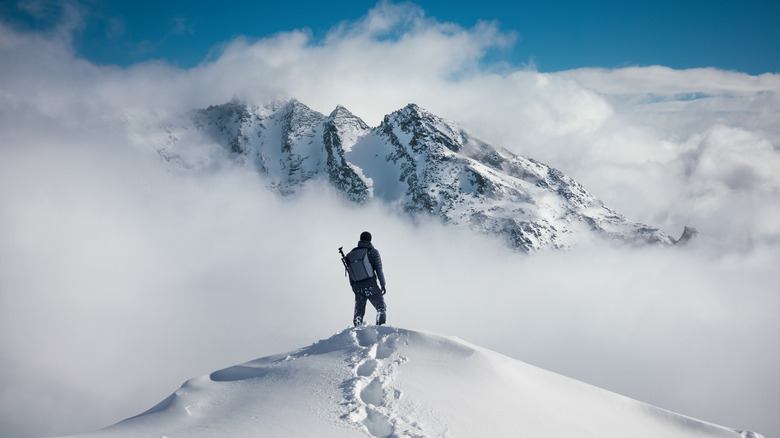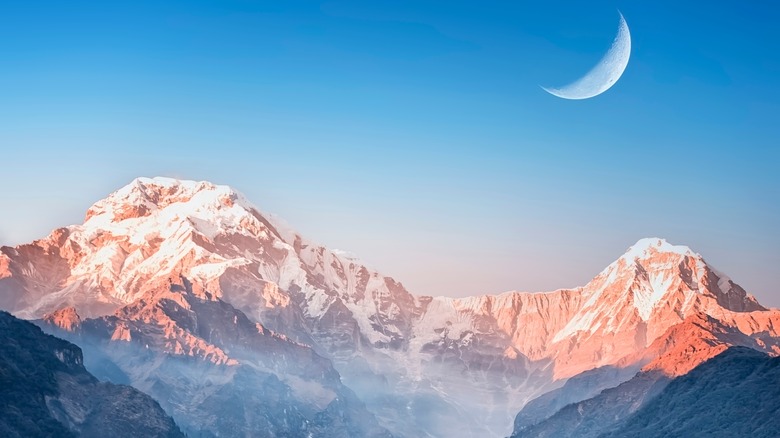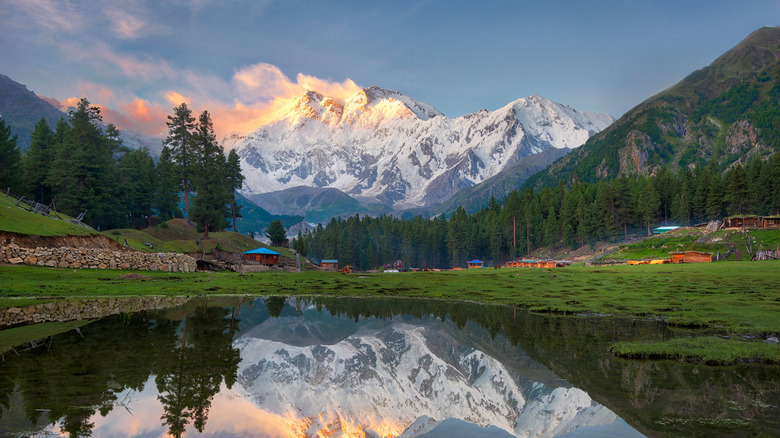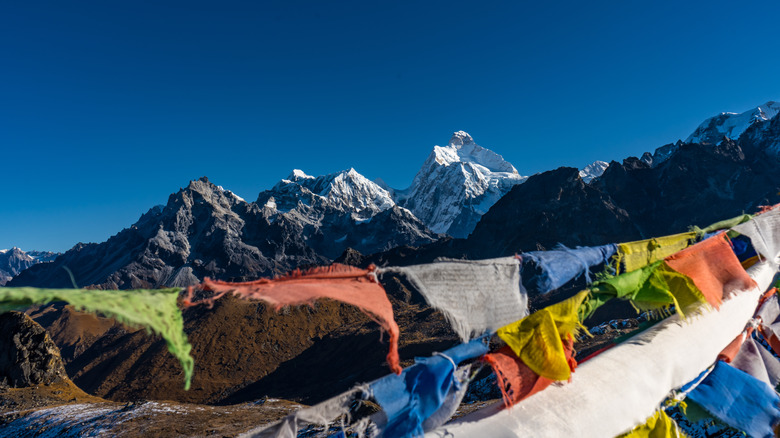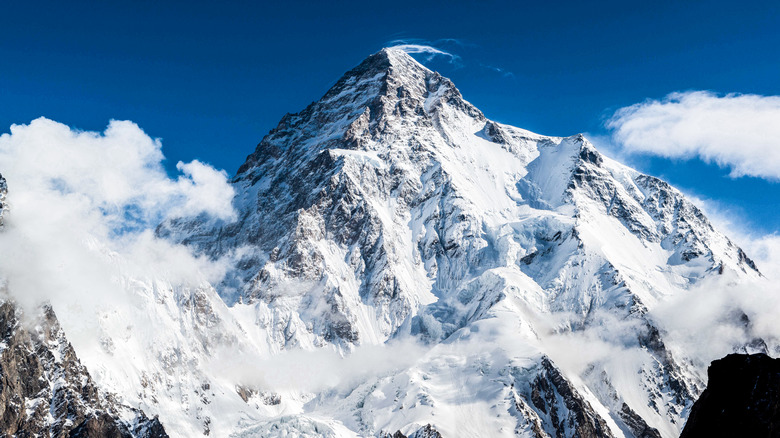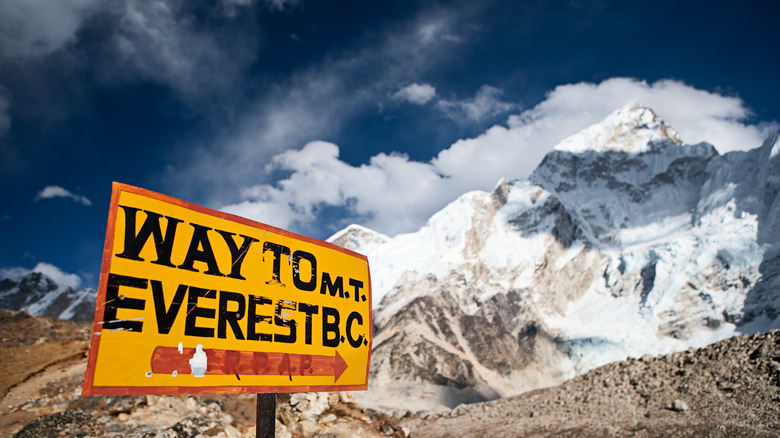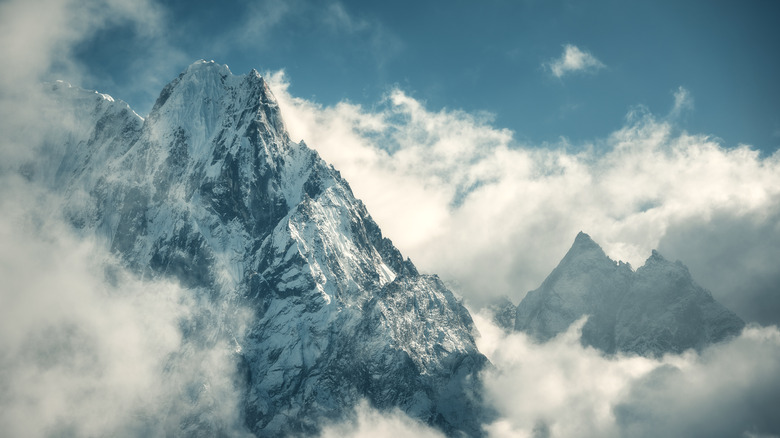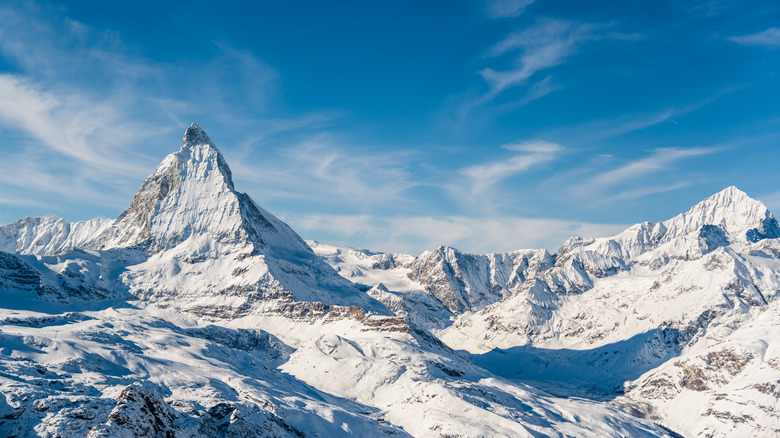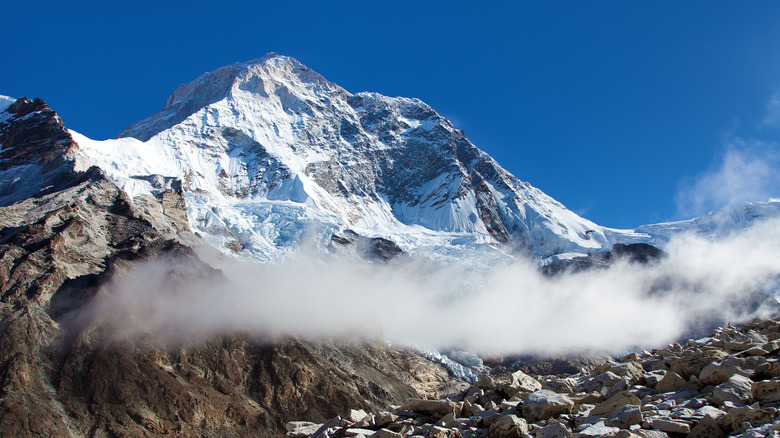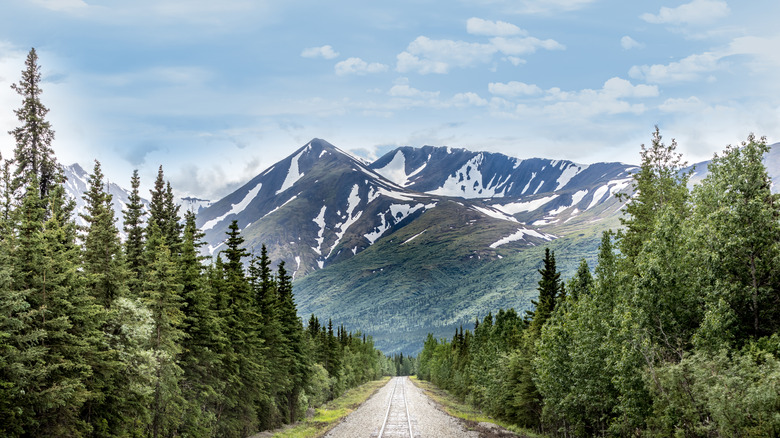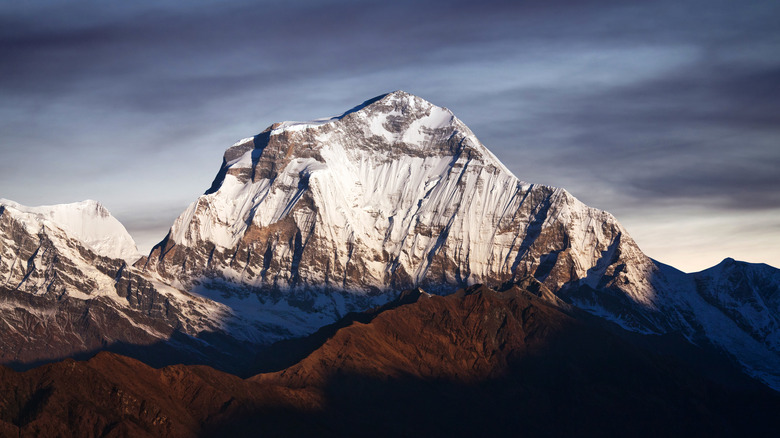10 Most Difficult Mountains To Climb In The World
Trying to conquer the world's most treacherous peaks is an endeavor reserved for the bravest, most skilled mountaineers, for reasons that can go far beyond the surface. The Annapurna mountain range, for instance, holds a significant amount of cultural significance and hosts many temples and Buddhist monasteries — truly marvelous sights to behold. While it's easy to know the tallest mountains in the world, colloquially known as the 8,000ers to climbers, what is even more essential to know are the peaks that are least accessible and, therefore, more dangerous.
There are multitudes of ways that a mountain can be difficult to traverse, all while testing the limits of human endurance and resilience. While these risks are often known and expected by experienced climbers, there are other factors separate from the peaks to be considered. Nanga Parbat's "Killer Mountain," for example, presents many technical challenges when it comes to climbing, which in recent years have caused accidental deaths from inexperience. On other peaks like Manaslu, the needs of larger groups that want to beat record times at a faster pace have caused accidents, such as avalanches.
No matter the height of the mountain, there are better practices that can keep one alive and safe. As retired mountaineering ranger Darryl Miller notes to the National Park Service, "You cannot make intelligent decisions in the wilderness if you do not understand the risks." Educating oneself about what makes a mountain dangerous is the first step to understanding these risks.
Annapurna I, Nepal
At just over 26,500 feet, Annapurna I is one of the four main summits of this approximately 30-mile-long mountain range between the Kali and Marsyandi Rivers. While traversing the entire Annapurna Circuit can take anywhere between 12 to 21 days, going all the way just to the summit of Annapurna I can take upwards of 17 days or more. And while this mountain was the first of the 8,000ers in history to be summited (by a French expedition in 1950), traversing this ridge has come at high costs.
Most know this mountain for its treacherous weather conditions, including avalanches and extreme winds, which have been coined as the "black wind" after the appearance of the vicious swirling winds that whip up dust and dirt along the ridge. Temperatures can drop to minus 4 degrees Fahrenheit or lower, and wind speeds can exceed 50 mph during storms. Its steep, icy slopes make it challenging even for experienced climbers, resulting in a 27% fatality rate, one of the highest among the 8,000ers.
Arlene Blum was the first woman to reach the summit of Annapurna I in 1978, but several of her all-female team of climbers passed away during the trek. When writing about this journey on her website, Blum says, "climbing the undulating rib-crest, we faced soft unstable snow and huge cornices. It was grueling and scary work." Other expedition groups have lost toes and fingers to frostbite and gangrene. Only 395 people have summited the mountain successfully.
Nanga Parbat, Nepal and Pakistan
Also classified as an 8,000er, Nanga Parbat is an attractive 26,660-foot peak for adventure seekers. Some mountaineers, like Naila Kiani, consider this peak a favorite due to its beautiful views along the base camp while calling the terrain a good "challenge." This mountain resides close to Fairy Meadow, a nature destination that, if you can stomach driving on the rough roads, leads to a beautiful glacial valley. While these characteristics may set one at ease, there are still many dangers to consider when traversing this dangerous mountain.
Translated to "Naked Mountain," Nanga Parbat is also known as the Killer Mountain because of the 31 lives claimed on its first initial ascent. The only thing predictable about this mountain is the weather, as mountaineer David Göttler tells National Geographic: "Nanga is like an island surrounded by way lower peaks and is really exposed to high winds and the weather in general. Due to that it has very short good-weather windows." Nanga Parbat is also notorious for its steep, avalanche-prone slopes.
The mountain's remote location adds to the challenges of rescue operations in case of emergencies. Currently, the mountain's fatality rate is around 22%. Climbers can make successful ascents during the warmer months, while in winter, temperatures can dip as low as minus 22 degrees Fahrenheit. One of the more popular routes up the mountain is via the western Diamir Face, which avoids the avalanche danger of massive hanging glaciers that threaten overhead.
Kangchenjunga, India and Nepal
At 28,169 feet tall, Kangchenjunga is the third-highest mountain in the world. The mountain is made up of five peaks that create one enormous massif, and some local legends even defer to this mountain as the home of the Yeti. However, local legends cannot hold a candle to the sheer force of the mountain, making it a force to be reckoned with for climbers and mountaineers.
This mountain is considered one of the most difficult to climb due to its unpredictable nature. Its placement along the underlying tectonic plates of the Earth's crust continues to generate a lot of pressure, causing frequent earthquakes and landslides. The latter makes the monsoon season the most dangerous time of year to trek up the mountain, as heavy rainfall can make the ascent exponentially more challenging. The dry seasons (October through May) offer cold but stable weather with a risk of heavy snowfall.
While fatality rates hover around 15%, the harsh, inconsistent weather can extend the length of a venture. As famed climber Phillippe Gatta remarks about his own venture up Kangchenjunga nearly two days before summiting, "At the end of the night we measure -20°C in the tent. Outside the wind and the snow are raging and our morale goes down. A few hours later the wind has stopped, it's sunny outside and the temperature rose to 35°C in the tent ... In the afternoon the weather deteriorates again, this weather is crazy and plays with our nerves."
K2, Pakistan and China
K2, the second-highest mountain in the world, stands at 28,251 feet tall and is renowned for its steep slopes and technical challenges, so much so that the mountain has been summited fewer times than Mount Everest, according to SummitClimb. Known as the "Savage Mountain," K2 is notorious for its high fatality rate among climbers at 18%, while Everest is only 3%, according to experts (via Business Insider).
The peak's level of danger is primarily due to avalanches, rockfall, and unpredictable weather, and K2's extremely steep faces demand strong technical skills to climb. There are several exposed and difficult sections to traverse, including the 100-foot crack called House's Chimney, the protruding Black Pyramid, and the famous Bottleneck Couloir, a slope far below the summit which is overhung by a number of unstable seracs. All this in temperatures dropping to minus 76 degrees Fahrenheit and winds exceeding 120 mph. This isn't a walk in the park.
However, these treacherous conditions have not stopped experienced climbers from taking on the challenge. A team of Nepali climbers made a historic ascent of K2 in Winter 2021, while 2022 was said to have been the busiest climbing season in world history, according to CNN. Overall, 706 intrepid explorers have summited this peak, with over 75% of climbers taking the Abruzzi Spur route, or the Southeast Ridge, the same route used for the peak's first ascent, achieved by an Italian team in 1954.
Mount Everest, China and Nepal
In its infamous glory, Mount Everest sits at 29,013 feet tall, showcasing extreme altitudes, harsh weather, and congested climbing routes during the climbing season. While the fatality rate has been noted at a relatively low 3%, this figure greatly depends on the climbing season and overall conditions.
Of course, the quest to climb the tallest mountain in the world comes with some obvious risks. Expeditions can take upwards of 60 days to complete, as climbers experience high winds up to 175 mph and temperatures as low as minus 75 degrees Fahrenheit. Then there's the perilous journey of entering the "Death Zone" after one surpasses 8,000 meters (26,200 feet) up the mountain. The air in this area gets so thin, where there is so little oxygen, that the body starts to die. "Your body is breaking down and essentially dying ... It becomes a race against the clock," according to Shaunna Burke (via Business Insider).
These conditions also mean that on the descent back through the Death Zone, climbers are at even higher risk of becoming ill, falling, and dying because of the health complications associated with this part of Everest. According to Endeavor Wealth Management, of the 192 deaths that occurred above Everest's base camp between 1921 and 2006, 56% of them were on the descent down the mountain. They don't call it the "Death Zone" without reason.
Manaslu, Nepal
The remote location of Manaslu in the Nepalese Himalayas and its limited access to rescue facilities contribute to its reputation as a dangerous climb. While it has a success rate of about 60% (according to Alan Arnette), most deaths that do happen on Manaslu are a result of avalanches and falls. And if the physicality of the 26,781-foot mountain isn't enough of a challenge, the toll on the body from the climb is something to consider, as altitude sickness and its complications are a serious threat. The decreased oxygen levels mean climbers must acclimatize carefully to prevent serious injury and potential death.
Weather also plays a large role in any climber's successful summit. Manaslu's weather is unpredictable, with heavy snowfall, strong winds, and rapid changes in between. Even the most experienced sherpas and guides can fall victim to the effects of harsh weather. In 2022, an avalanche on Manaslu killed Nepali guide Dawa Chhiring Sherpa, someone who had summitted Everest at least five times. The fatality of the mountain alone is about 9%, which is relatively high because of the technical skill required to ascend the mountain carefully. Mountaineers who wish to climb Manaslu are advised to trek in the spring when travel is less risky, and the weather is usually better. The journey to the summit can take about 14 to 18 days, with climbers averaging about 7.5 miles a day.
The Matterhorn, Switzerland and Italy
The majestic Matterhorn is iconic, beautiful, and deadly — this 14,692-foot mountain has claimed over 500 lives of those climbing or descending its famous peak since 1865. In today's world, the peak's popularity prolongs this danger as many eager tourists attempt to climb without experience or a guide. Between 3,000 and 4,000 people attempt to climb Matterhorn every year, with about 65% never reaching the top due to physical fitness or weather conditions.
Notorious for its steep and exposed rock faces, the mountain's famous pyramid-shaped peak presents significant challenges to climbers, including difficulty finding routes and extreme altitude changes. The Hörnligrat is the main route climbers take to traverse this mountain, although it also happens to be particularly dangerous due to sliding and falling rocks. This gets even worse when warm weather arrives each year, according to group leader Jan Beutel. "When the high mountains thaw in summer, the stiffness decreases and the ground sediments get soggy and wobbly with water," which can lead to the mountainside crumbling and becoming increasingly unstable (as Beutel told Smithsonian Magazine). Though the trek up to the summit does not usually take more than a few days for experienced climbers, those who do so should take the weather into consideration to avoid these types of conditions. If you are inexperienced or not in the best physical shape, it might be best to give this famous peak a miss.
Makalu, Nepal
Though Makalu is the fifth-highest mountain in the world, it has not had a high number of visitors or summit attempts, and it's not because Mount Everest is only 12 miles away. The primary reason for Makalu's relative lack of visitor attention is that it is highly technical to traverse and requires a lot of experience. On this peak alone exists sloped glaciers, sharp-edged ridges, and both rock and ice climbing. Not to mention that to fully summit, it is advised to transport oxygen supplies and risk altitude sickness and exhaustion. Around 500 people have scaled this 27,838-foot mountain, with about 20 fatalities in total.
Another deterrent for this mountain is that there are no tea huts or towns offering shelter along the traveled routes, making it one of the most remote trekking areas in the area. Isolation also means increased risk in case of emergencies. Though it is advised to venture onto Makalu anytime besides monsoon season, there are still cases where weather conditions can make climbing difficult. Tim Taylor, a photographer for WIRED, even remarks that on his group's journey along Makalu, they encountered a strange natural occurrence — an electrical storm without thunder or lightning. "The air just began to hum, as did all the metal equipment attached to our bodies and packs ... We began to receive painful electric shocks, like hundreds of tiny needles being driven into your skin," Taylor says.
Denali, Alaska, U.S.
Also known as Mount McKinley, Denali is the highest peak in North America at 20,310 feet tall. The mountain's remote location in Alaska and its technical challenges make it a highly challenging and dangerous climb that takes about three weeks to complete. About 500 people tend to complete this climb to the summit during its peak season. However, there is much more than the technical aspects of this mountain that make it difficult.
In an article for 57 Hours, AMGA ski guide and Seven Summiter Bill Allen said that Denali poses serious threats from normal climbing risks such as altitude sickness, extreme weather, and temperature to specific geographic threats like grizzly bears. Denali also has extreme weather conditions, with winds that can go as fast as 100 mph and temperatures that can drop to minus 40 degrees Fahrenheit.
There are several ways to traverse the mountain depending on what the weather conditions are like; there are at least 30 routes, with the Cassin Ridge route being one of the most traveled. Climbers are encouraged to get to each of the four camps in Denali National Park at a "safe but quick pace," which can pose difficulties due to the need to acclimatize. Move too fast, and the danger rises, as noted by Denali Mountaineering Rangers. "[...] Going from 14,000 feet to the summit of Denali is a whole different undertaking. There are very few mountaineers capable of moving fast enough to accomplish this safely," (via NPS).
Dhaulagiri I, Nepal
Dhaulagiri I is the seventh-largest mountain on the planet, sitting at 26,795 feet above sea level. It is known by locals as the White Mountain for its snowy facade. While very popular for those who enjoy climbing peaks within the 8,000ers category (with over 400 successful summits), there are aspects of the mountain that still make it one of the more dangerous treks to take on. There have been a total of 70 deaths since 1954. While the 7% fatality rate is somewhat lower than many mountains on this list, most of these deaths are attributed to avalanches, which are unpredictable.
Ice and snow play major roles in accidents while trekking up Dhaulagiri I, particularly because there are four faces of the mountain, with at least one route for each face. While each route tackles challenging sections, including snowy ridges and glaciers, the West Face is the least frequented due to the difficulty in navigating over crevasses and through ice slopes. No matter the route taken, climbers can experience temperatures as low as minus 40 degrees Fahrenheit and wind speeds upwards of 62 mph. Many experienced guides note that the best route to take when traversing Dhaulagiri is based on weather conditions, the preferences of the climbing team, and the expertise of the climbers.
